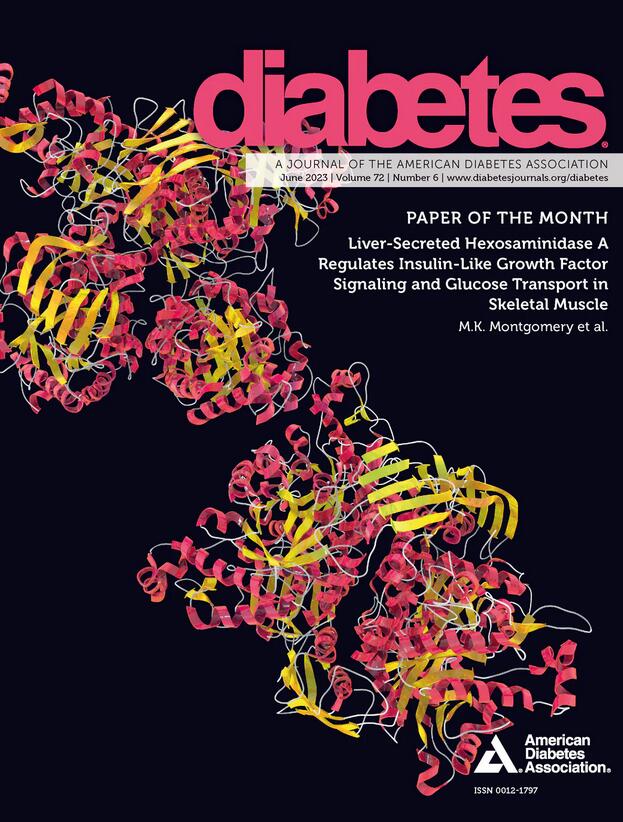Metabolome-Wide Mendelian Randomization and Observational Study Reveal Causal Links Between Circulating Metabolites and Youth-Onset Type 2 Diabetes
IF 7.5
1区 医学
Q1 ENDOCRINOLOGY & METABOLISM
引用次数: 0
Abstract
Despite the increasing prevalence of type 2 diabetes in youth, its causal associations with circulating biomarkers remain elusive. We first aimed to identify circulating metabolites causally linked to youth-onset type 2 diabetes using Mendelian randomization (MR). By analyzing 675 metabolites from large metabolomic European genome-wide association studies (GWAS) and data on youth type 2 diabetes from the multiancestry Progress in Diabetes Genetics in Youth (ProDiGY) consortium, we identified 34 candidate metabolites. Among these, phosphatidylcholine (pc) ae C42:3 and propionylcarnitine provided the strongest evidence of association with youth-onset type 2 diabetes, based also on positive genetic colocalization and sensitivity analyses accounting for adiposity. Among the 34 candidate metabolites, 23 were retained following colocalization and a replication MR using independent metabolomic GWAS and testing effects on adult type 2 diabetes. Furthermore, we validated associations of six of these metabolites with glucose metabolism–related traits in an observational study in the Avon Longitudinal Study of Parents and Children (ALSPAC). Notably, pc ae C42:3 levels at age 7 years were linked to dysglycemia and insulin resistance in adolescence. These findings underscore the dynamic role of metabolites in glucose metabolism in childhood, offering insights for future screening and treatment strategies. ARTICLE HIGHLIGHTS Metabolism is key in the pathogenesis of type 2 diabetes in both children and adults, and large-scale metabolomic studies offer a unique source for discovery of biomarkers for these conditions. Leveraging human genetics, we explored whether altered levels of circulating metabolites in the blood are causally linked to type 2 diabetes in youth across different ancestries. Our Mendelian randomization analysis identified causal associations for 34 metabolites, and, among these, Mendelian randomization replication and colocalization prioritized 23 metabolites. Observational evidence from the Avon Longitudinal Study of Parents and Children (ALSPAC) study validated effects on glucose homeostasis for six of these metabolites, among which phosphatidylcholine ae C42:3 emerged as the most promising biomarker. These findings highlight the role of metabolism in glucose homeostasis pathophysiology in youth.全代谢组孟德尔随机化和观察性研究揭示了循环代谢物与青年发病2型糖尿病之间的因果关系
尽管2型糖尿病在青少年中的患病率越来越高,但其与循环生物标志物的因果关系仍然难以捉摸。我们首先利用孟德尔随机化(MR)确定与青年发病型2型糖尿病有因果关系的循环代谢物。通过分析来自大型代谢组学欧洲全基因组关联研究(GWAS)的675种代谢物和来自青年糖尿病遗传学多祖先进展(ProDiGY)联盟的青年2型糖尿病数据,我们确定了34种候选代谢物。其中,磷脂酰胆碱(pc) ae C42:3和丙酰肉碱提供了与青年发病2型糖尿病相关的最有力证据,这也是基于阳性遗传共定位和肥胖敏感性分析。在34个候选代谢物中,23个在共定位和使用独立代谢组学GWAS的复制MR和测试对成人2型糖尿病的影响后被保留。此外,我们在雅芳父母和儿童纵向研究(ALSPAC)的一项观察性研究中验证了这些代谢物中的六种与葡萄糖代谢相关特征的关联。值得注意的是,7岁时的pc ae C42:3水平与青春期的血糖异常和胰岛素抵抗有关。这些发现强调了代谢物在儿童葡萄糖代谢中的动态作用,为未来的筛查和治疗策略提供了见解。代谢是儿童和成人2型糖尿病发病机制的关键,大规模代谢组学研究为发现这些疾病的生物标志物提供了独特的来源。利用人类遗传学,我们探索了血液中循环代谢物水平的改变是否与不同祖先的年轻人的2型糖尿病有因果关系。我们的孟德尔随机化分析确定了34种代谢物的因果关系,其中,孟德尔随机化复制和共定位优先考虑了23种代谢物。来自雅芳父母和儿童纵向研究(ALSPAC)的观察证据证实了这些代谢物中的六种对葡萄糖稳态的影响,其中磷脂酰胆碱ae C42:3成为最有希望的生物标志物。这些发现强调了代谢在青年葡萄糖稳态病理生理中的作用。
本文章由计算机程序翻译,如有差异,请以英文原文为准。
求助全文
约1分钟内获得全文
求助全文
来源期刊

Diabetes
医学-内分泌学与代谢
CiteScore
12.50
自引率
2.60%
发文量
1968
审稿时长
1 months
期刊介绍:
Diabetes is a scientific journal that publishes original research exploring the physiological and pathophysiological aspects of diabetes mellitus. We encourage submissions of manuscripts pertaining to laboratory, animal, or human research, covering a wide range of topics. Our primary focus is on investigative reports investigating various aspects such as the development and progression of diabetes, along with its associated complications. We also welcome studies delving into normal and pathological pancreatic islet function and intermediary metabolism, as well as exploring the mechanisms of drug and hormone action from a pharmacological perspective. Additionally, we encourage submissions that delve into the biochemical and molecular aspects of both normal and abnormal biological processes.
However, it is important to note that we do not publish studies relating to diabetes education or the application of accepted therapeutic and diagnostic approaches to patients with diabetes mellitus. Our aim is to provide a platform for research that contributes to advancing our understanding of the underlying mechanisms and processes of diabetes.
 求助内容:
求助内容: 应助结果提醒方式:
应助结果提醒方式:


